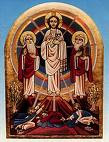Humility Step Twelve: Incarnation
It is important to read the whole of the passage traditionally assigned as the day's reading for the Twelfth Step of Humility. This is because what appears under the Twelfth Step proper looks to moderns like a caricature of mopey Christianity at its worst: a joyless, scrupulous sinner always hanging his head and taking no pleasure in life.
It is quite a reversal to read that after we have climbed all these steps, we will "come to that perfect love of God that casts out fear [possibly my favorite line in all the Rule!]." We will 'delight in virtue!" That is to say, we will take delight in things that were meant to be delightful, doing the right things for the right reasons, one with God, infused with the Holy Spirit.
This is one of only three unambiguous references to the Holy Spirit in the Rule. Tellingly, one of the other places is in Chapter 49 on Lent (the only chapter with two references to 'joy'). Here and there, you might read that St. Benedict is deficient in Christology and Pneumatology (the study of the Holy Spirit). Personally, I think that such judgments are weak, inasmuch as St. Benedict was writing a Rule for beginners and not a theological treatise. Be that as it may, surely the inclusion of the Holy Spirit at the top of the Ladder of Humility is significant.
Is there a dynamic link between step twelve and the conclusion to this chapter? I believe there is. Saint Benedict writes that 'by his very appearance' the monk makes his humility 'manifest'. 'Appearance' is really not strong enough for the Latin original, which says, si non solum corde monachus, sed etiam ipso corpore humilitatem videntibus. I would offer the translation thus: not only should the monk have humility in his heart (cf. Step 7), but even in his very body it should be seen. This emphasis on the exteriorization and embodiment of what has become deeply interior and spiritual is the fruit of the Incarnational spirituality that monastic humility seeks. We see a reflection of the great Christological hymn of Philippians 2: 6-11, in which Christ empties Himself, going down as low as He can go, so as to be exalted by His Father. The monk, too, realizing that he is a sinner and certainly less worthy than his Master, retreats in humility so as to displayed by the Lord as the image of Christ, as an alter Christus.
For this to happen, the monk must be completely emptied of all self-possession, so as to be 'overshadowed' by the Holy Spirit. His embodiment as alter Christus is thus a new instance of the Incarnation. The monk becomes also an altera Maria, giving birth to Christ by the power of the Holy Spirit. The monk furthermore enters into God's Kingdom in a prefigured way, being as it were already at the final judgment, living in a continual Advent, awaiting the redemption that we seek as Christians.
So the Ladder of Humility leads to a spirituality of Incarnation and of hope. This paradox is explicable if we understand that any manner of self-reliance blocks the indwelling Spirit from transforming us into saints, into alteri Christi. The true monk is so confident in God's love and mercy that he is willing to confront the sad truth about his own unwillingness to be saved, in order to be illuminated by the triumphant truth about God and God's love, that the Holy Trinity means to save us and take us into His bosom of love. As we wait in joyful hope for Christ's coming, let us not fear to climb the Ladder of Humility. When we find the way hard, let us receive assurance from St. Benedict, so that as the descriptions of each step resonate with our experience, we have the strength to continue climbing and be ready to welcome Christ at His return.

No comments:
Post a Comment